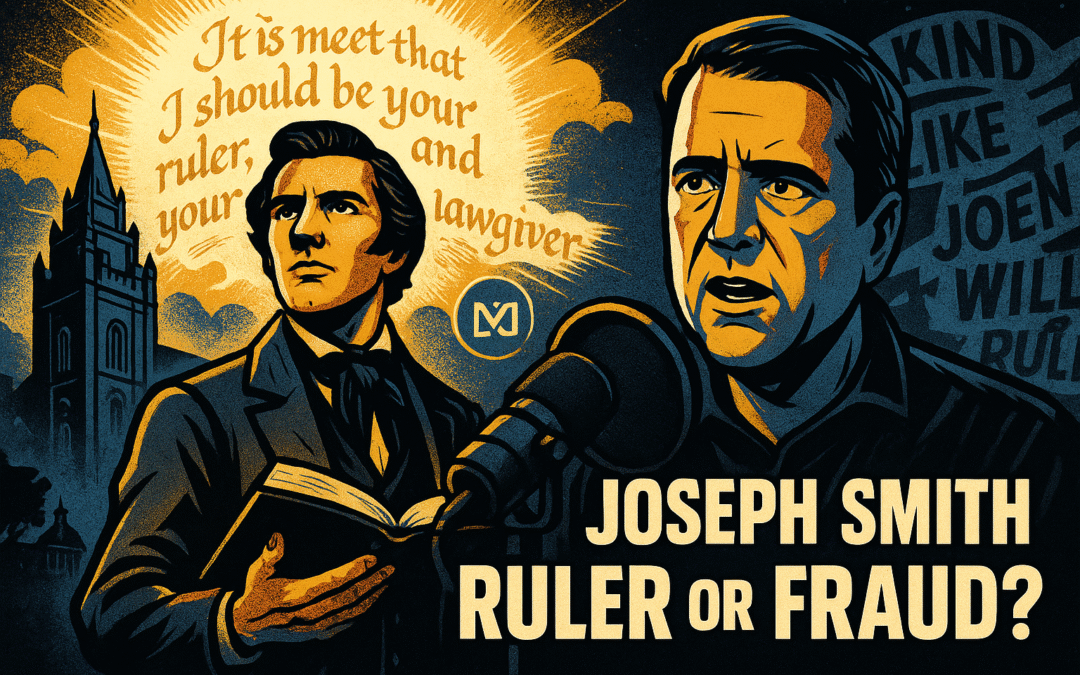
by Anonymous | Aug 9, 2025 | Joseph Smith
Bottom Line
The claim that Joseph equated himself with divine rulership is a distortion. The text plainly exalts Christ, not Joseph. This is scripture misrepresented as ambition.
| Podcast |
Mormon Stories – Joseph Smith Podcast |
| Episode |
Ep. 2046 – John Turner Pt. 9 |
| Category |
Prophetic Authority & Revelation Misrepresentation |
| Quote |
“He receives a revelation basically where he says he has Jesus saying, ‘I will be your ruler’ … it’s kind of like Joseph saying, ‘I will be your ruler.’ … That combined with ‘I am Joseph the prophet.’ That’s a level of hubris…” — John Dehlin, 00:36:29–00:38:29:contentReference[oaicite:0]{index=0} |
| Core Claim |
Joseph Smith used divine revelation as a mask for personal power, equating “Jesus will be your ruler” with “Joseph will be your ruler.” |
| Conclusion |
False / Rhetorically Misleading |
| Logical Questions |
- Is the “I will be your ruler” phrase directly from Jesus Christ in canonized scripture?
- Does the context of the revelation support Dehlin’s inference?
- Is there a pattern in Joseph’s early revelations that shows consolidation of personal power?
|
🔍 Core Finding
This quote grossly distorts the meaning of Doctrine and Covenants 41:4, which reads:
“He that receiveth my law and doeth it, the same is my disciple… for it is meet that I should be your ruler, and your lawgiver.”
— D&C 41:4
The speaker is Jesus Christ, not Joseph Smith. The verse continues a scriptural tradition of divine kingship:
- Isaiah 33:22: “The Lord is our king.”
- Mosiah 2:19: “Ye are eternally indebted to your heavenly King.”
- 2 Nephi 10:14: “He that fighteth against Zion… shall be as a garment in a furnace of fire.”
Joseph’s leadership followed a revealed structure, with checks and ratification by councils and membership. D&C 28:2 makes clear:
“No one shall be appointed to receive commandments and revelations in this church excepting my servant Joseph Smith, Jun.”
— D&C 28:2
Bottom Line
The claim that Joseph equated himself with divine rulership is a distortion. The text plainly exalts Christ, not Joseph. This is scripture misrepresented as ambition.
📚 Sources
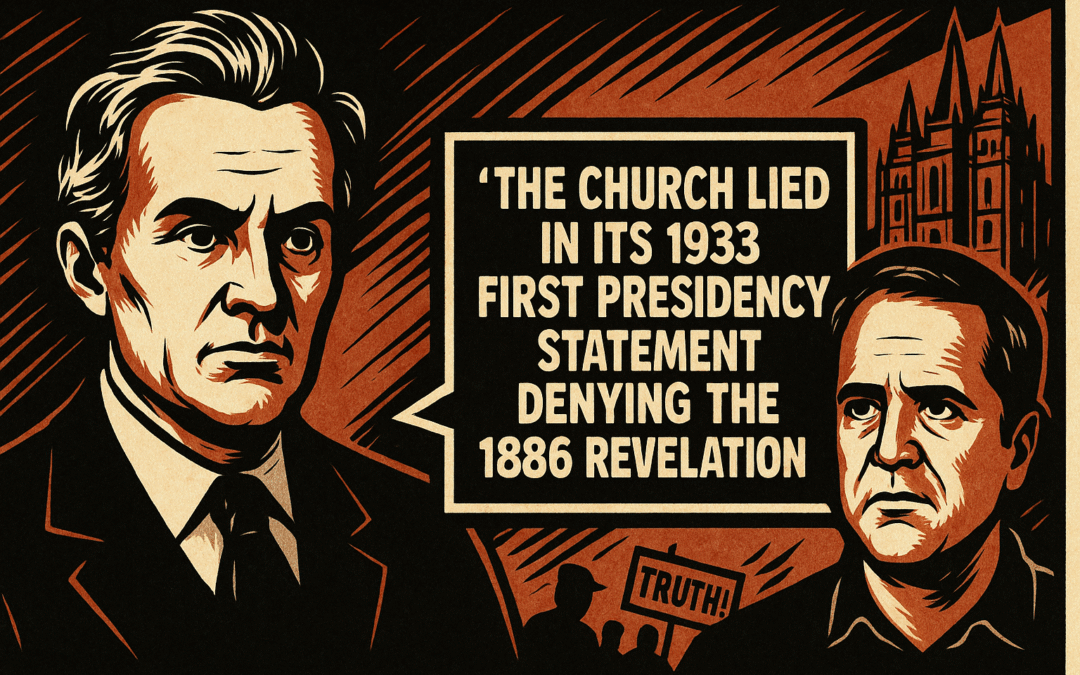
by Anonymous | Aug 9, 2025 | Church Leaders
1933 First Presidency Statement
Bottom Line
A poorly worded official statement isn’t proof of lies. Public policy is established by canon—not by retroactive accusations or ideological frustration. The Church lied in its 1933 First Presidency statement denying the 1886 revelation”
| Podcast |
Mormon Stories – John Dehlin |
| Episode |
“New Document Shows LDS Church Hid and Denied its own Prophet’s Polygamy Revelation” |
| Title |
“The Church lied in its 1933 First Presidency statement denying the 1886 revelation” |
| Category |
Institutional Transparency & Doctrine |
| Quote |
“This is one of the biggest whoppers ever told by church leaders… Unambiguously this was a very terrible idea.” — Narrator, 01:21:37–01:21:55 |
| Timestamp |
01:21:37–01:21:55 |
| Core Claim |
The Church knowingly lied about the 1886 revelation in the 1933 First Presidency statement. |
| Conclusion |
False Accusation / Misleading Framing |
| Logical Questions |
- Was the 1886 revelation known and authenticated by Church leaders in 1933?
- Does public release equal doctrinal adoption?
- Can mistaken or strategic language be equated with intentional lying?
|
🔍 Core Finding
The 1933 First Presidency statement, drafted by J. Reuben Clark, expressed skepticism about the doctrinal relevance of the 1886 revelation. While the phrasing may have downplayed its existence or status, there’s no verifiable evidence of intentional deceit.
The revelation was never canonized, never presented for common consent, and never treated as binding doctrine by the Church. Leaders are not required to treat every private document—however authentic—as public doctrine. The Church’s statements aimed to protect its position against schismatic interpretations, not hide scripture.
⚖️ Doctrine by Common Consent
- No revelation is binding until sustained by the Church as a whole (D&C 26:2).
- The 1886 revelation remained non-canonical for nearly 150 years.
- Canon omission ≠ coverup; doctrinal restraint is not deception.
📚 Sources
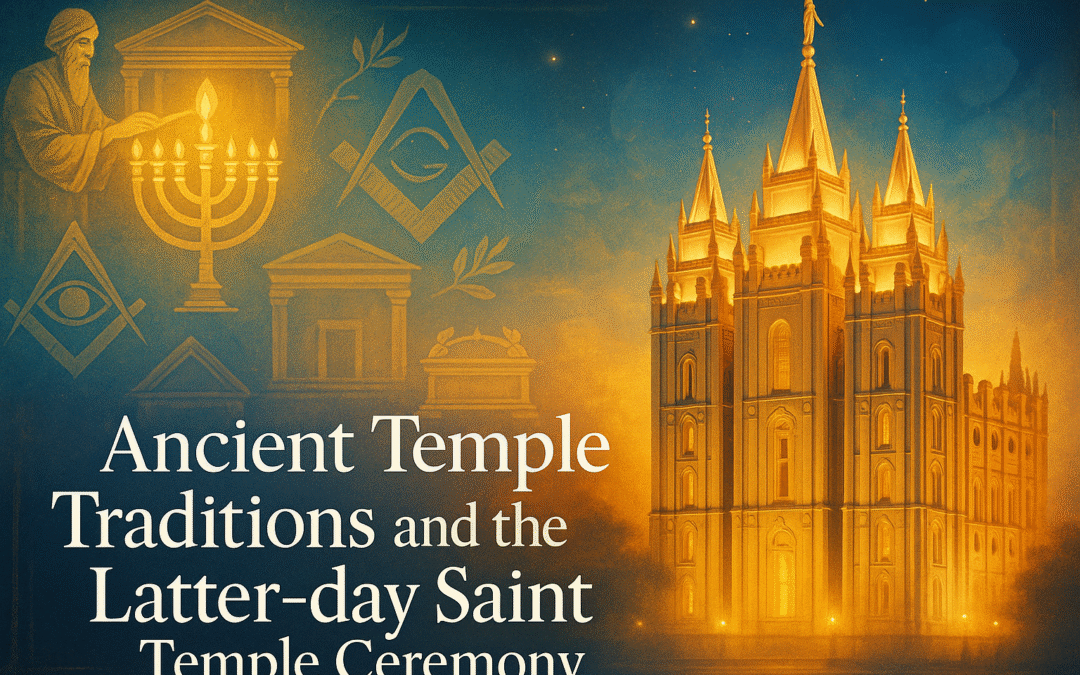
by Anonymous | Aug 9, 2025 | Doctrines Policy Practice
Ancient Temple Traditions and the Latter-day Saint Temple Ceremony
Abstract: This paper explores the origins, structure, and theological claims of the Latter-day Saint (LDS) temple ceremony, particularly the Endowment, in comparison with ancient Israelite and early Christian temple traditions. It incorporates scholarship from both LDS and non-LDS sources, including the work of Margaret Barker, and evaluates common critiques against the LDS temple experience from a doctrinal, historical, and psychological perspective. The paper ultimately argues for a pattern of restoration that connects modern LDS temple worship with ancient sacred traditions and practices.
Introduction
The temple holds a central place in Latter-day Saint theology and worship. Yet for many modern Christians—and especially former members of the Church of Jesus Christ of Latter-day Saints—the temple ceremony can seem unfamiliar, unnecessary, or even troubling. This study aims to evaluate whether the LDS temple ceremony is grounded in historical religious practices and if it is, as Latter-day Saints claim, a restoration of ancient ordinances and symbols.
1. Ancient Israelite Temple Worship
Temple rituals in ancient Israel involved washings, anointings, sacred clothing, covenants, and access restrictions to sacred spaces. The High Priest entered the Holy of Holies once a year, wearing white linen and performing sacrificial atonement (see Leviticus 16). These forms find reflection in the LDS temple, especially in the Initiatory and Endowment rituals.
Scriptural references: Exodus 28–30; Leviticus 16; 2 Chronicles 3–5.
2. Margaret Barker and the First Temple Tradition
Methodist scholar Margaret Barker has posited that King Josiah’s reforms around 623 BCE removed elements of Israel’s older temple theology—such as the divine feminine (Asherah), visionary ascent theology, and the role of the High Priest as a mediator figure. Barker’s work has been received positively by many LDS scholars due to its alignment with Latter-day Saint temple doctrines, including belief in a Heavenly Mother and sacred rituals as a means of ascending into the divine presence.
Barker’s key texts: The Older Testament, Temple Theology, Great High Priest.
3. Josiah’s Reforms: Loss or Purification?
2 Kings 22–23 describes Josiah’s purge of high places and the “discovery” of a lost book of the law, which many scholars identify as an early version of Deuteronomy. Barker argues that these reforms may have suppressed legitimate temple teachings such as wisdom traditions, anointing rites, and the divine feminine. LDS scriptures such as the Book of Mormon claim that “plain and precious” truths were taken from ancient records (1 Nephi 13).
4. Early Christianity and Temple Imagery
Early Christians saw Jesus as the new High Priest (Hebrews 9–10), and the temple veil’s tearing as symbolic of broader access to God—not the end of ritual or sacred space. Many early Christian communities maintained liturgical practices, including washings (baptism), anointings (chrism), sacred meals (Eucharist), and even marriage as a sacred rite (see Gospel of Philip).
Early Christian texts such as the Acts of John and other apocryphal writings describe prayer circles, ritual clothing, sacred names, and esoteric instruction—patterns echoed in the LDS Endowment.
5. Latter-day Saint Temple Worship: Restoration or Innovation?
Joseph Smith introduced the Endowment in 1842. Critics note similarities to Freemasonry, which Smith had recently joined. However, LDS leaders and scholars argue that Freemasonry preserved degraded fragments of ancient temple ritual, and that Joseph Smith received revelatory restoration of their original spiritual purpose. Core LDS temple covenants—obedience, sacrifice, chastity, and consecration—are not found in Masonic rites and align more closely with biblical covenants.
6. Modern Criticisms and Responses
a. The Veil Was Rent
Many Christians argue that Christ’s death made temples obsolete. LDS theology agrees that the veil’s tearing symbolizes open access to God—but contends that sacred ordinances and covenants still structure the process of entering His presence.
b. Masonic Influence
While Freemasonry and the LDS temple share superficial elements, the purpose, theology, and symbolic meaning differ significantly. Ritual washings, anointings, garments, and sacred handclasps appear in ancient texts independently of Masonry.
c. Changes Over Time
The temple ceremony has been adapted—most notably in 1990 and 2019—but the core doctrines and covenants remain unchanged. This aligns with the LDS belief in continuous revelation and is consistent with biblical precedent (e.g., Acts 15, changes to circumcision and dietary laws).
d. Secrecy and Psychological Objections
Critics sometimes describe the temple as secretive or emotionally challenging. Latter-day Saints understand temple teachings as sacred rather than secret, drawing on early Christian principles of the disciplina arcani. LDS leaders have also responded to valid concerns, making adjustments to improve clarity and inclusion (e.g., gendered language revisions in 2019).
7. Do the Parallels Prove Antiquity?
No one ancient source contains all elements of the LDS Endowment, but a constellation of practices—washings, anointings, priestly clothing, sacred names, ritual ascent, and symbolic marriages—do appear across ancient Judaism, Christianity, and early mystery traditions.
The cumulative case made by LDS scholars (e.g., Hugh Nibley, Jeffrey Bradshaw, David Calabro) is that these parallels support—not prove—the temple’s ancient roots. Margaret Barker’s independent findings further strengthen the plausibility of restoration claims.
Conclusion
The LDS temple ceremony stands at the crossroads of ancient and modern, ritual and revelation. Though modern audiences may find it foreign or challenging, its core elements—covenant, purification, symbolic ascent, and eternal union—mirror the most sacred traditions of the ancient world.
While gaps in historical continuity remain, the temple endowment exhibits unmistakable resonance with the sacred drama of temples past. Whether viewed as symbolic, psychological, or revelatory, the LDS temple invites all to ponder this ancient question anew: What does it mean to come into the presence of God?
References (Selected)
- Barker, Margaret. The Gate of Heaven: The History and Symbolism of the Temple in Jerusalem. SPCK, 1991.
- ———. The Great High Priest: The Temple Roots of Christian Liturgy. T&T Clark, 2003.
- Dever, William. Did God Have a Wife? Eerdmans, 2005.
- Bradshaw, Jeffrey M. Temple Themes in the Book of Moses. Interpreter Foundation, 2014.
- Hamblin, William J. “Vindicating Josiah.” Interpreter, Vol. 4, 2013.
- Nibley, Hugh. Temple and Cosmos. Deseret Book, 1992.
- Gospel of Philip (Nag Hammadi Codex II,3), trans. Wesley Isenberg.
- Hebrews 9–10; Exodus 28–30; 2 Kings 23; 1 Corinthians 15:29.
- Interpreter Foundation, FAIR, Encyclopedia of Mormonism (Prayer Circle), LDS General Handbook (2020–present).
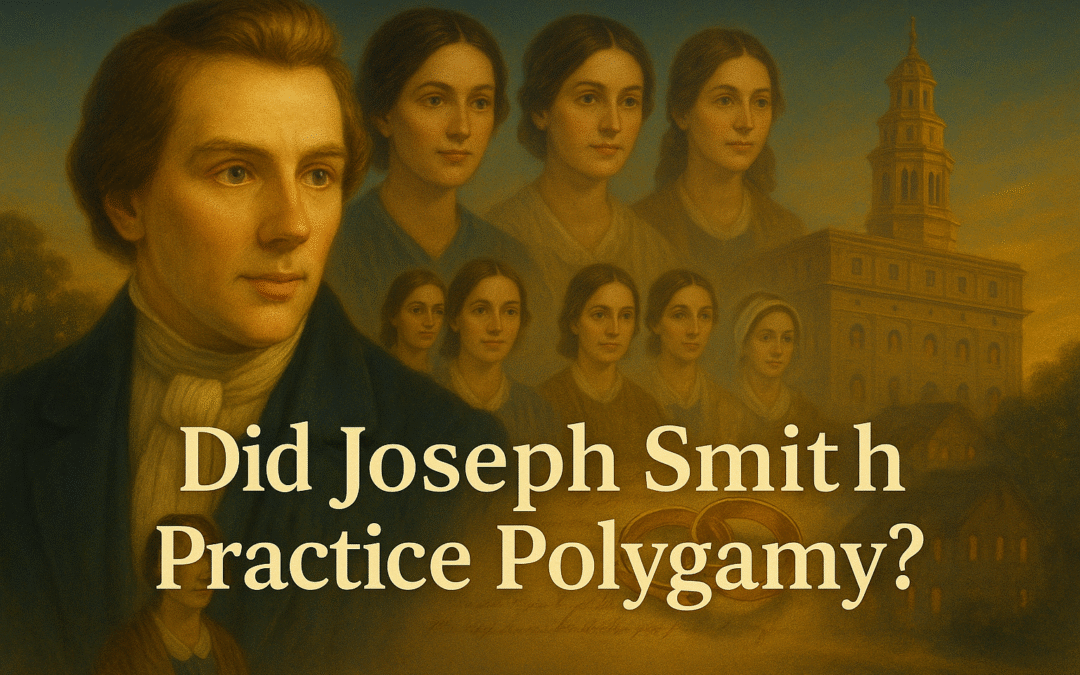
by Anonymous | Aug 9, 2025 | Doctrine, Doctrines Policy Practice, Joseph Smith
Executive Brief: Did Joseph Smith Practice Polygamy?
Core question: Did Joseph Smith
begin the practice of plural marriage, or did Brigham Young introduce it after
Joseph’s death?
⏳
Timeline Overview
- 1830–1835: Public monogamy;
possible sealing to Fanny Alger.
- 1841–1844: Joseph secretly seals
to 30+ women in Nauvoo. D&C 132 dictated in 1843.
- June 1844: Nauvoo Expositor
exposes polygamy. Joseph and Hyrum killed.
- 1852: Brigham Young announces
polygamy and publishes D&C 132.
- 1860: RLDS founded under Joseph
Smith III, denying Joseph practiced polygamy.
📚
Evidence That Joseph Smith Originated Polygamy
- D&C 132: Dictated July 12, 1843 by Joseph Smith; scribed by William Clayton. Validated
by Clayton, Hyrum Smith, and Kingsbury.
- Plural Wives: Sealed to 29–33
women including Eliza R. Snow, Emily Partridge, Helen Mar Kimball. (Compton, Hales)
- Sexual Relations: Emily Partridge
and Melissa Lott testified under oath to conjugal relations with Joseph.
- Church Acknowledgment: The LDS
Church confirmed Joseph practiced polygamy in the 2014 Gospel Topics essay.
- Scholarly Consensus: Confirmed by
Bushman, Compton, Hales, and even modern RLDS historians.
🔍
The Case That Brigham Young Originated or Exaggerated Polygamy
- Public Denials: Joseph publicly
said he had only one wife, even weeks before his death.
- Emma Smith: Denied Joseph ever
practiced or taught polygamy.
- RLDS Tradition: Joseph Smith III
gathered affidavits supporting his father’s innocence.
- D&C 132 Skepticism: Not
published until 1852. Survives only in copies. Edits by Willard Richards raise
timeline questions.
- Scriptural Conflicts: Book of
Mormon (Jacob 2:24) and Joseph’s JST edits condemn David & Solomon’s plural
marriages.
📊
Comparative Analysis
| Category |
Joseph Started It |
Brigham Invented It |
| Historical Evidence |
Dozens of journals, affidavits, and sealing records |
No
contemporary documents from Joseph; D&C 132 published
posthumously |
| Witness Testimony |
Emily Partridge, Malissa Lott, Eliza Snow, William
Clayton |
Emma
Smith, Joseph Smith III, William Marks, RLDS statements |
| Church Position |
LDS
acknowledges Joseph introduced it |
RLDS
originally denied it, now acknowledges it historically |
| Conspiracy Burden |
No
whistleblowers from 70+ alleged participants |
Requires massive, silent conspiracy by Brigham and all Utah
leaders |
| Scriptural Support |
D&C 132, patriarchal precedents |
Jacob 2, JST changes, 1835 D&C monogamy clause |
Conclusion: What We Know and What Remains Uncertain
We know:
- Joseph
Smith secretly practiced polygamy in Nauvoo.
- Brigham
Young openly continued and expanded it in Utah.
- The LDS
Church affirms Joseph’s involvement; RLDS once denied it but later conceded to
the evidence.
Uncertain:
- Joseph’s
private feelings and motivations
- Whether
all sealings were consummated
- Emma’s
true level of knowledge and emotional coping
- Why no
children resulted from plural unions
“Joseph Smith did
practice plural marriage—even if he kept it secret. Brigham Young didn’t invent
it; he exposed it. That’s what the evidence shows.”
Want more?
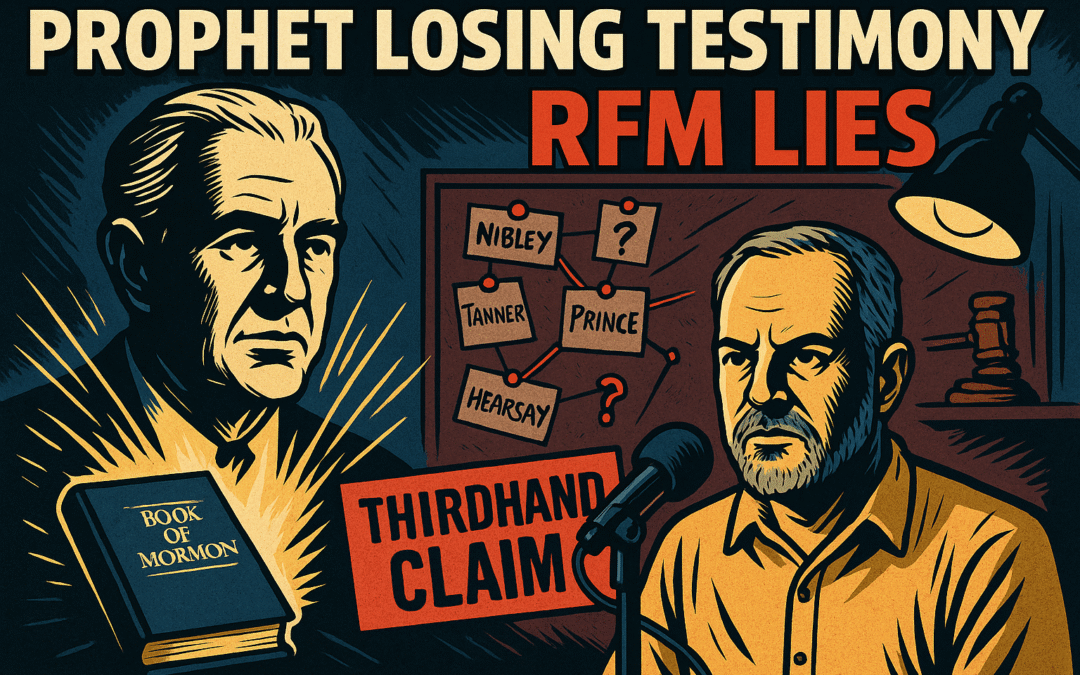
by Anonymous | Jul 28, 2025 | Church Leaders
Bottom Line
This is theological fiction repackaged as history. McKay’s testimony was firm. Nibley’s writings were firm. The idea that the Book of Mormon was merely authored by Joseph Smith is not supported by any contemporary Church documentation. If it were true, Nibley or McKay’s journals would say so. They do not.
| Podcast |
Radio Free Mormon |
| Episode |
409 |
| Category |
Book of Mormon Historicity / Leadership Faith |
| Quote |
“David McKay told Hugh Nibley that, ‘Well, we already know that Joseph Smith wrote the Book of Mormon.'” — RFM quoting Gregory Prince quoting Hugh Nibley (Gregory Prince Interview, 00:08:00–00:08:35) |
| Core Claim |
David O. McKay privately confessed disbelief in the Book of Mormon’s ancient origins to Hugh Nibley. |
| Conclusion |
Misleading / Conjectural / Unverifiable |
| Logical Questions |
- Is this quote from David O. McKay documented firsthand?
- Was the conversation verified beyond Nibley’s secondhand, posthumous retelling?
- Does any public or private writing from McKay contradict this?
|
🔍 Core Finding
This quote is a thirdhand hearsay anecdote: Gregory Prince interviewing Hugh Nibley in 1995 about a conversation from the 1960s. The comment was allegedly shared only after Nibley asked Prince to turn off the recorder, then repeated with vague phrasing. There is no documentation in McKay’s journals, First Presidency minutes, or public sermons that supports the idea he rejected the Book of Mormon’s divinity.
Meanwhile, Nibley continued his vigorous public defense of the Book of Mormon throughout the rest of his life—publishing books, teaching at BYU, and never recounting this incident. O.C. Tanner’s influence is exaggerated and conjectural. The idea that McKay reversed lifelong beliefs due to Tanner is narrative embellishment.
📆 Documentary Silence vs. Doctrinal Certainty
- McKay bore testimony of the Book of Mormon repeatedly in Conference and private interviews.
- The claim has no support in firsthand writings or verified audio.
- Nibley’s own writings contradict the idea that he believed McKay denied scripture.
🤖 Statement Against Interest? Or Misremembered?
Podcast host RFM cites legal hearsay exceptions to suggest this is trustworthy. But courts require corroboration. This lacks any. No independent evidence. No diary entry. No tape. And it appears decades after McKay’s death.
📚 Sources
⚠️ Manipulation & Logic Check
- Fallacy: Argument from Silence – Absence of denial is treated as evidence of belief change.
- Fallacy: Guilt by Association – Links McKay to Tanner with no evidence.
- Rhetorical Manipulation: Anecdotal elevation, authority laundering through Prince/Nibley names.
🚨 Defamation & Legal Risk Layer
Although McKay is deceased, the claim borders on “false light” misrepresentation. It assigns beliefs to him contrary to all known public statements. The claim lacks due diligence and presents potential reckless disregard for factual accuracy.





